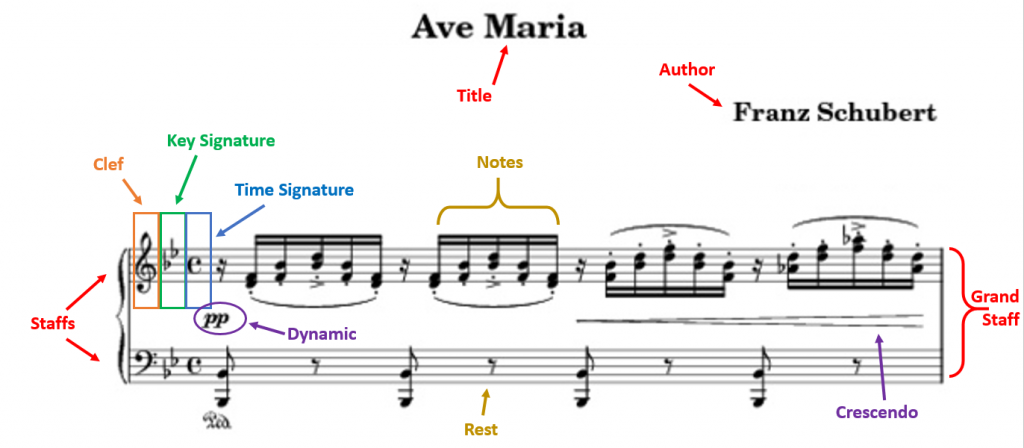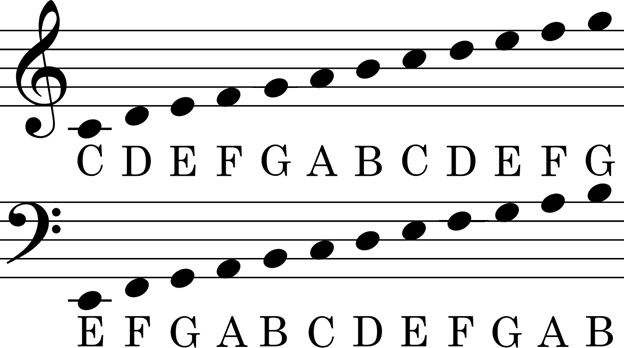Score
What is a Score?
The word ‘score’ is used in a lot of different ways in music. In the broadest sense, it can mean any kind of sheet music – these terms are sometimes used interchangeably. More narrowly, it can describe the ‘full score,’ or a single musical document that contains all the different parts for an orchestral performance. A score is usually used for a more formal, coordinated piece, like a classical sonata or a big-band jazz tune. If you’re working in a more informal style like blues or rock and roll, you probably won’t see the music written down in a score.
‘Score’ also describes the cinematic soundtrack of a movie – the background music that plays underneath all the action. Once the movie has been edited, composers ‘score’ it by composing music that will complement the plot and events on screen, as well as punctuating the rhythms and providing an added layer of emotional expression. These film scores are mostly orchestral, so they can be written in a full score.
In this article, we’ll focus on the full score. These documents are mainly used by conductors and band leaders, since they’re the ones that need to be able to look at all the different parts simultaneously. There are also individual scores that you can buy for each instrument – vocal scores for singers, cello scores for cellists, and so on. For the most part, they follow the same rules as a full score, but they only show information for a single instrument rather than covering the whole orchestra. There are also ‘miniature scores’ available from some music publishers, which print the music in small, portable booklets (these usually contain only the score for a single part – otherwise they’d have to print way too small!)
We’ll also be focused on how scores are used in Western music. But of course Western culture isn’t the only one that has developed a system for writing down music. Indian, Chinese, and lots of other civilizations have their own systems – we just usually don’t use the word ‘score’ to describe them.
Parts of a Score
When looking at a full score, the first thing you’ll notice is that the page is broken out into different parts for different instruments. This helps you imagine what’s going on in the whole orchestra rather than just zeroing in on a single instrument.
In this example, the score is set up for 14 instrumental groups and shows all of their different parts:
Notice how some of the lines are very busy, while others have almost no notes on them at all. For example, the contrabass (bottom line) has notes to play throughout. But the timpani (6th from the bottom) is almost silent after the first couple of measures. If you know how to read music, you can look at this single page and start to imagine how all the different parts will intertwine, creating harmonies and counterpoints in your mind. Most of us, of course, are not that skilled at reading music.
How to Read a Score
Most of the time, you won’t be reading the entire score for a piece of music. The composer would certainly do that, or maybe a conductor. But for an individual musician, what matters most is your own part. If you’re playing the viola, you might want to look over the violin part so that you know how their role in the performance will intersect with your own. But it’s usually not necessary to read over the whole score – you can just listen to the orchestra when you rehearse with them.
Once you’ve identified your instrument on the page, reading a score is just like reading any other piece of sheet music. You can find more details on this process in the article on sheet music, but for now we’ll just cover the basics.
After looking at the title and author, your eye should next go to the staffs. As we saw before, a full score has several parallel staffs, each corresponding to a single instrument. Sometimes, though, an instrument requires two staffs. This is often true for writing piano music, since pianos have such a huge range of pitches that they can make, and demand two hands working independently to play them. So those instruments get a grand staff, or two staffs tied together with a bracket.
Once you know which instrument belongs to which staff, you need to know what the staff represents. The clef gives you that information. Different clefs give different meanings to the lines and spaces of the staff, so you can’t read anything on a staff until you know what the clef is. Alongside the clef is a key signature, which gives slight modifications to the meaning of the lines and spaces. This example has ‘flat’ symbols (♭) on the space for E and the line for D. So all the E’s change to E♭ and all the D’s change to D♭ on this staff.
So now you have all the information you need to read the lines and spaces of the staff. But what about the actual music? Before you can read that, you have to understand the basic structure of the rhythm, and for that you need the time signature. The time signature tells you how many beats go in each measure, and what rhythmic value is represented by each kind of note or rest. In this case, the symbol c represents ‘common time’ or 4/4. That means four beats per measure, and the quarter note counts as one beat. Finally, the score will also have instructions about the dynamics, or loudness of the music. This example is telling you to start very quiet (pianissimo) and gradually get louder (crescendo).
OK! That was a lot of information before we even got to the music itself. But now we’re ready to look at the lines and spaces and work out what they mean. Remember that the meaning of each line or space is defined by the clef, and there are two main clefs: the treble clef () and the bass clef (
). Here are the meanings of each line and space in the different clefs:
Now that you know which pitch belongs where, you can look at the different rhythmic values. Once you have both pitch and rhythm, you’ll have everything you need to play the song!
Whole note/rest: hold for four beats (the ‘whole’ measure if it has 4 beats)






